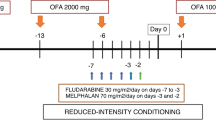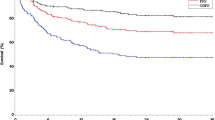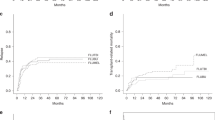Abstract
Autologous hematopoietic stem cell transplantation (ASCT) is curative for a proportion of patients with relapsed/refractory (R/R) Hodgkin lymphoma (HL). However, there is a small group of patients with high-risk of relapse after ASCT that might benefit from other approaches. We conducted a retrospective analysis on 126 patients treated with tandem ASCT-reduced intensity conditioning (RIC)-allogeneic-SCT and reported to the EBMT registry to analyze the efficacy and safety of this approach. Patients were included if they had received an ASCT followed by a planned RIC-SCT in <6 months without relapse between the procedures. The median time between diagnosis and ASCT was 16 months (2–174). The median number of lines prior to ASCT was two (33% of the patients received >3 lines). Forty-one percent were transplanted with active disease. The median follow-up was 44 months (6–130). Three-year-progression-free survival (PFS), overall survival (OS), incidence of relapse (IR), and non-relapse mortality (NRM) after the tandem were 53% (45–64), 73% (65–81), 34% (24–42), and 13% (8–21), respectively. This is the largest series analyzing the efficacy and safety of a tandem approach in R/R HL. The low NRM and IR with promising PFS and OS suggest that this might be an effective procedure for a high-risk population.
This is a preview of subscription content, access via your institution
Access options
Subscribe to this journal
Receive 12 print issues and online access
$259.00 per year
only $21.58 per issue
Buy this article
- Purchase on Springer Link
- Instant access to full article PDF
Prices may be subject to local taxes which are calculated during checkout




Similar content being viewed by others
References
Schmitz N, Pfistner B, Sextro M, Sieber M, Carella AM, Haenel M, et al. Aggressive conventional chemotherapy compared with high-dose chemotherapy with autologous haemopoietic stem-cell transplantation for relapsed chemosensitive Hodgkin’s disease: a randomised trial. Lancet. 2002;359:2065–71.
Younes A, Sureda A, Ben-Yehuda D, Zinzani PL, Ong T-C, Prince HM, et al. Panobinostat in patients with relapsed/refractory Hodgkin’s lymphoma after autologous stem-cell transplantation: results of a phase II study. J Clin Oncol. 2012;30:2197–203.
Gibb A, Jones C, Bloor A, Kulkarni S, Illidge T, Linton K, et al. Brentuximab vedotin in refractory CD30+ lymphomas: a bridge to allogeneic transplantation in approximately one quarter of patients treated on a Named Patient Programme at a single UK center. Haematologica. 2013;98:611–4.
Corazzelli G, Angrilli F, D’Arco A, Ferrara F, Musto P, Guarini A, et al. Efficacy and safety of bendamustine for the treatment of patients with recurring Hodgkin lymphoma. Br J Haematol. 2013;160:207–15.
Anastasia A, Carlo-Stella C, Corradini P, Salvi F, Rusconi C, Pulsoni A, et al. Bendamustine for Hodgkin lymphoma patients failing autologous or autologous and allogeneic stem cell transplantation: a retrospective study of the Fondazione Italiana Linfomi. Br J Haematol. 2014;166:140–2.
Younes A, Gopal AK, Smith SE, Ansell SM, Rosenblatt JD, Savage KJ, et al. Results of a pivotal phase II study of brentuximab vedotin for patients with relapsed or refractory Hodgkin’s lymphoma. J Clin Oncol. 2012;30:2183–9.
Sarina B, Castagna L, Farina L, Patriarca F, Benedetti F, Carella AM, et al. Allogeneic transplantation improves the overall and progression-free survival of Hodgkin lymphoma patients relapsing after autologous transplantation: a retrospective study based on the time of HLA typing and donor availability. Blood. 2010;115:3671–7.
Crocchiolo R, Castagna L, Fürst S, El-Cheikh J, Faucher C, Oudin C, et al. Tandem autologous-allo-SCT is feasible in patients with high-risk relapsed non-Hodgkin’s lymphoma. Bone Marrow Transplant. 2013;48:249–52.
Garcia-Sanz R, Sureda A, de la Cruz F, Canales M, Gonzalez AP, Pinana JL, et al. Brentuximab vedotin and ESHAP is highly effective as second-line therapy for Hodgkin lymphoma patients (long-term results of a trial by the Spanish GELTAMO Group). Annals of oncology: official journal of the European Society for. Med Oncol. 2019;30:612–20.
Moskowitz CH, Nademanee A, Masszi T, Agura E, Holowiecki J, Abidi MH, et al. Brentuximab vedotin as consolidation therapy after autologous stem-cell transplantation in patients with Hodgkin’s lymphoma at risk of relapse or progression (AETHERA): a randomised, double-blind, placebo-controlled, phase 3 trial. Lancet. 2015;385:1853–62.
Moskowitz CH, Walewski J, Nademanee A, Masszi T, Agura E, Holowiecki J, et al. Five-year PFS from the AETHERA trial of brentuximab vedotin for Hodgkin lymphoma at high risk of progression or relapse. Blood. 2018;132:2639–42.
Lazarus HM, Loberiza FR, Zhang MJ, Armitage JO, Ballen KK, Bashey A, et al. Autotransplants for Hodgkin’s disease in first relapse or second remission: a report from the autologous blood and marrow transplant registry (ABMTR). Bone Marrow Transplant. 2001;27:387–96.
Arai S, Fanale M, DeVos S, Engert A, Illidge T, Borchmann P, et al. Defining a Hodgkin lymphoma population for novel therapeutics after relapse from autologous hematopoietic cell transplant. Leuk Lymphoma. 2013;54:2531–3.
Carella AM, Cavaliere M, Lerma E, Ferrara R, Tedeschi L, Romanelli A, et al. Autografting followed by nonmyeloablative immunosuppressive chemotherapy and allogeneic peripheral-blood hematopoietic stem-cell transplantation as treatment of resistant Hodgkin’s disease and non-Hodgkin’s lymphoma. J Clin Oncol. 2000;18:3918–24.
Castagna L, Crocchiolo R, Giordano L, Bramanti S, Carlo-Stella C, Sarina B, et al. High-dose melphalan with autologous stem cell support in refractory Hodgkin lymphoma patients as a bridge to second transplant. Bone Marrow Transplant. 2015;50:499–504.
Mariotti J, Bramanti S, Devillier R, Furst S, El Cheikh J, Sarina B, et al. Tandem autologous-haploidentical transplantation is a feasible and effective program for refractory Hodgkin lymphoma. Bone Marrow Transplant. 2018;53:366–70.
Cheson BD, Pfistner B, Juweid ME, Gascoyne RD, Specht L, Horning SJ, et al. Revised response criteria for malignant lymphoma. J Clin Oncol. 2007;25:579–86.
Bacigalupo A, Ballen K, Rizzo D, Giralt S, Lazarus H, Ho V, et al. Defining the intensity of conditioning regimens: working definitions. Biol Blood Marrow Transplant. 2009;15:1628–33.
Glucksberg H, Storb R, Fefer A, Buckner CD, Neiman PE, Clift RA, et al. Clinical manifestations of graft-versus-host disease in human recipients of marrow from HL-A-matched sibling donors. Transplantation. 1974;18:295–304.
Terwey TH, Vega-Ruiz A, Hemmati PG, Martus P, Dietz E, le Coutre P, et al. NIH-defined graft-versus-host disease after reduced intensity or myeloablative conditioning in patients with acute myeloid leukemia. Leukemia. 2012;26:536–42.
Morschhauser F, Brice P, Fermé C, Diviné M, Salles G, Bouabdallah R, et al. Risk-adapted salvage treatment with single or tandem autologous stem-cell transplantation for first relapse/refractory Hodgkin’s lymphoma: results of the prospective multicenter H96 trial by the GELA/SFGM study group. J Clin Oncol. 2008;26:5980–7.
Deau B, Amorim S, Perrot A, Quittet P, Cornillon J, Chaoui D, et al. Tandem haematopoietic stem cell transplantation for high risk relapsed/refractory Hodgkin lymphoma: a LYSA study. Br J Haematol. 2018;181:341–9.
Chen R, Palmer JM, Thomas SH, Tsai N-C, Farol L, Nademanee A, et al. Brentuximab vedotin enables successful reduced-intensity allogeneic hematopoietic cell transplantation in patients with relapsed or refractory Hodgkin lymphoma. Blood. 2012;119:6379–81.
Armand P, Engert A, Younes A, Fanale M, Santoro A, Zinzani PL, et al. Nivolumab for relapsed/refractory classic hodgkin lymphoma after failure of autologous hematopoietic cell transplantation: extended follow-up of the multicohort single-arm phase ii checkmate 205 trial. J Clin Oncol. 2018;36:1428–39.
Connors JM, Jurczak W, Straus DJ, Ansell SM, Kim WS, Gallamini A, et al. Brentuximab vedotin with chemotherapy for stage III or IV Hodgkin’s lymphoma. N Engl J Med. 2018;378:331–44.
Armand P, Chen Y-B, Redd RA, Joyce RM, Bsat J, Jeter E, et al. PD-1 blockade with pembrolizumab for classical Hodgkin lymphoma after autologous stem cell transplantation. Blood. 2019;134:22–9.
LaCasce AS, Bociek RG, Sawas A, Caimi P, Agura E, Matous J, et al. Brentuximab vedotin plus bendamustine: a highly active first salvage regimen for relapsed or refractory Hodgkin lymphoma. Blood. 2018;132:40–8.
Kanate AS, Kumar A, Dreger P, Dreyling M, Le Gouill S, Corradini P, et al. Maintenance therapies for hodgkin and non-Hodgkin lymphomas after autologous transplantation: a consensus project of ASBMT, CIBMTR, and the Lymphoma Working Party of EBMT. JAMA Oncol. 2019;5:715–22.
Acknowledgements
LB and AS performed the research. LB, HF, IK, DB, NF, LC, EF, PC, NM, PB, ED, MG, PC, MH, MM, AT, DC, and SN contributed to clinical data. LB, AB, SM, and AS contributed to the analysis and data interpretation. AB served as the statistician. All authors contributed to review, provided their comments on this manuscript and approval the final version.
Author information
Authors and Affiliations
Consortia
Corresponding author
Ethics declarations
Conflict of interest
Authors do not report any conflict of interest in the present manuscript.
Additional information
Publisher’s note Springer Nature remains neutral with regard to jurisdictional claims in published maps and institutional affiliations.
This study has been presented as an oral presentation at 46st Annual Meeting of the European Society for Blood and Marrow Transplantation on the 26th March 2019 and at 24th European Haematology Association Congress on the 16th June 2019.
Rights and permissions
About this article
Cite this article
Bento, L., Boumendil, A., Finel, H. et al. Tandem autologous-reduced intensity allogeneic stem cell transplantation in high-risk relapsed Hodgkin lymphoma: a retrospective study of the Lymphoma Working Party—EBMT. Bone Marrow Transplant 56, 655–663 (2021). https://doi.org/10.1038/s41409-020-01075-y
Received:
Revised:
Accepted:
Published:
Issue Date:
DOI: https://doi.org/10.1038/s41409-020-01075-y



